6 April-28 May 2014. Oh good Lord, poor Cyprus. Just about every European empire that has ever existed has laid claim to Cyprus – Mycenaean Greeks, Assyrians, Egyptians, Persians, Egyptians again, Romans, Byzantines, Arab caliphates, French Lusignans, Venetians, then for over three hundred years the Ottoman, or Turkish Empire, and finally the British. It was granted independence in 1960, but the Greek Cypriots and the Turkish Cypriots had a running battle that erupted in 1974 and resulted in the partition of the island with the northeastern part of the island becoming a separate political entity that is recognized only by Turkey. The dispute continues to simmer. The British also still have military bases there. Since 2004 it has been a member of the European Union.
For one small island it sure has seen a lot of action. For a very very long time. There are indications that human activity dates back as far as 10,000 BC.
Our own activity is very low key due to recovering from various illnesses and exhaustion from all our travels around South America but we manage to do some exploring in between reading and sleeping, although we never do get to the Turkish sector.
We live in the town of Pyla just outside of Larnaca. We go for walks along the boardwalk by the water, we go into town for groceries, we go to Mario’s for ice-cream, sometimes we stop for lunch at the aptly named Mer Bleue restaurant right on the beach looking out over the endless sapphire blue Mediterranean, and we go for walks along CTO Beach.
In Larnaca, when we are finally ready to explore a little, we visit the beautiful Hala Sultan Tekke Mosque. Most Turkish Cypriots follow Sunni Islam, while most Greek Cypriots are members of the Greek Orthodox Church. Hala Sultan Tekke is considered by some to be the third holiest of all Sunni Islam sites, and is a place of pilgrimage.
The mosque is situated next to the Larnaca Salt Lake inhabited by a flock of flamingoes. Cyprus has flamingoes! Who knew?
Right in the town of Larnaca is the Church of Saint Lazarus, built in the late 9th century, and one of only three Byzantine churches to have survived in Cyprus.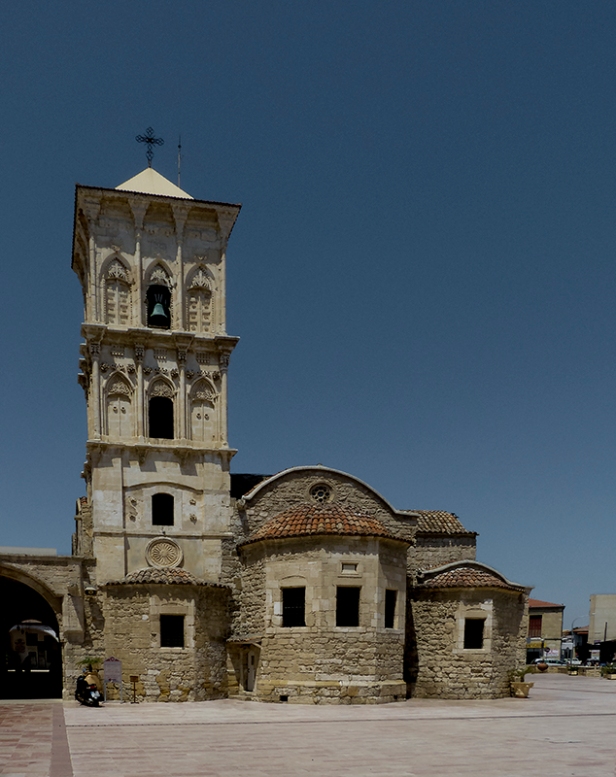
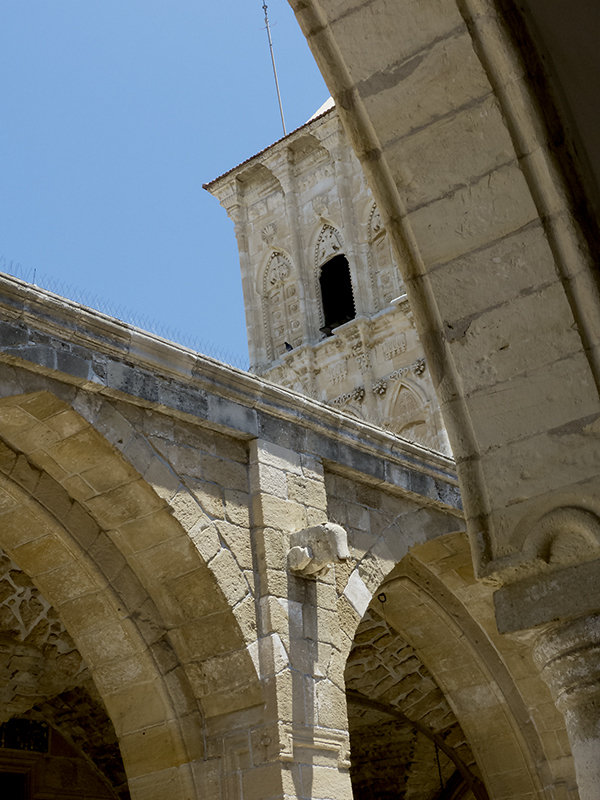
All Greek Orthodox churches have an iconostasis, a moveable wall of religious icons usually placed to separate the nave from the sanctuary, which contains the altar. We are endlessly charmed by their golden gorgeousness. Every church we go into has an iconostasis and for us it is always the most beautiful thing to see. The Church of Saint Lazarus is no exception.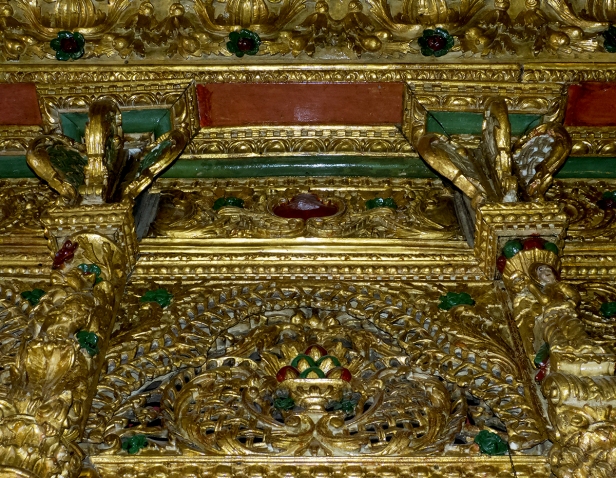
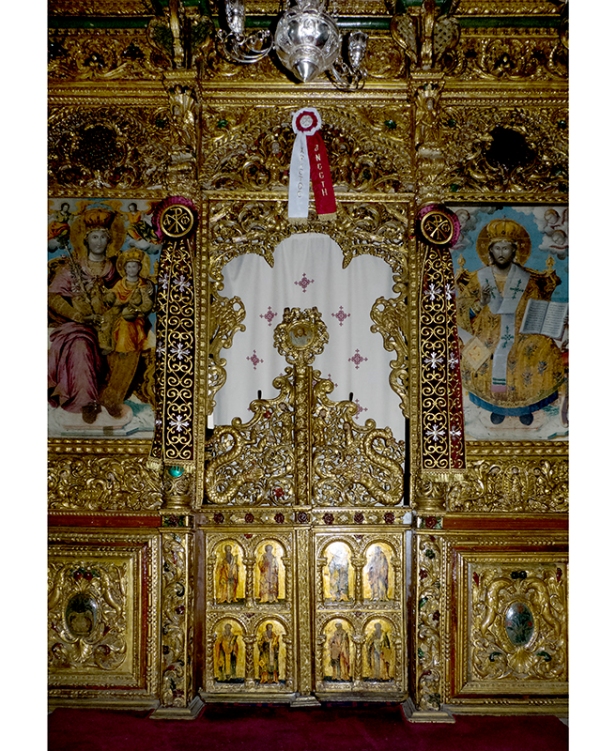
For our first real “adventure”, when we’ve finally roused ourselves enough to go exploring beyond our immediate area, we head to the resort town of Ayia Napa. The early 16th century eponymous monastery, once in a forested area near a sleepy fishing village, is now the best-known landmark in a thriving resort town noted for its golden-sand beaches and flourishing nightlife and clubbing scene. We find a teeming beach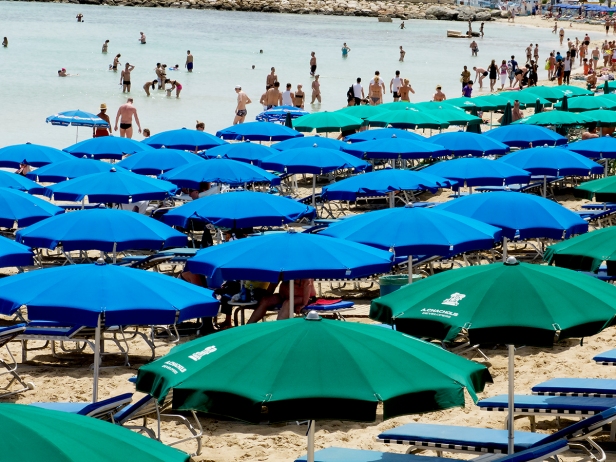
and many red roasted Brits. (And Russians, Scandinavians, Greeks, Germans and Swiss.)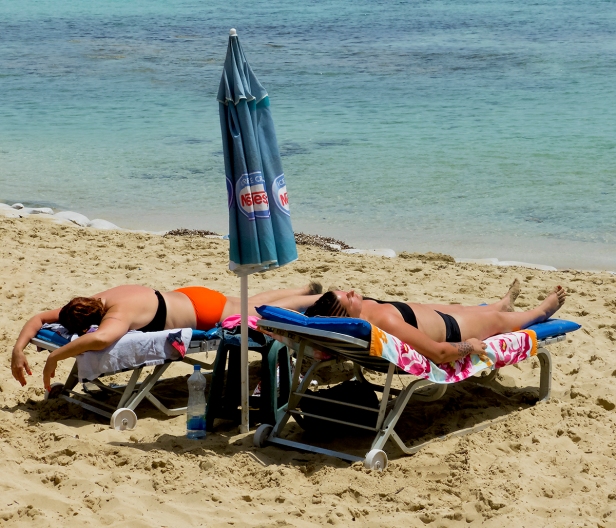
But despite the changes and development, vestiges of village life remain. Sausages must be hung to dry apparently. What better place than the carport?
According to legend a hunter found a glowing icon of the Virgin Mary in a cave in the forest. It had probably been placed there during the period of iconoclasm, possibly as early as the 7th century. After the hunter rediscovered it in the 14th century the cave was built into a church. The name, Ayia Napa means Holy Forest. The medieval Venetian monastery was built in 1500 around the cave and church, and was restored in 1950.

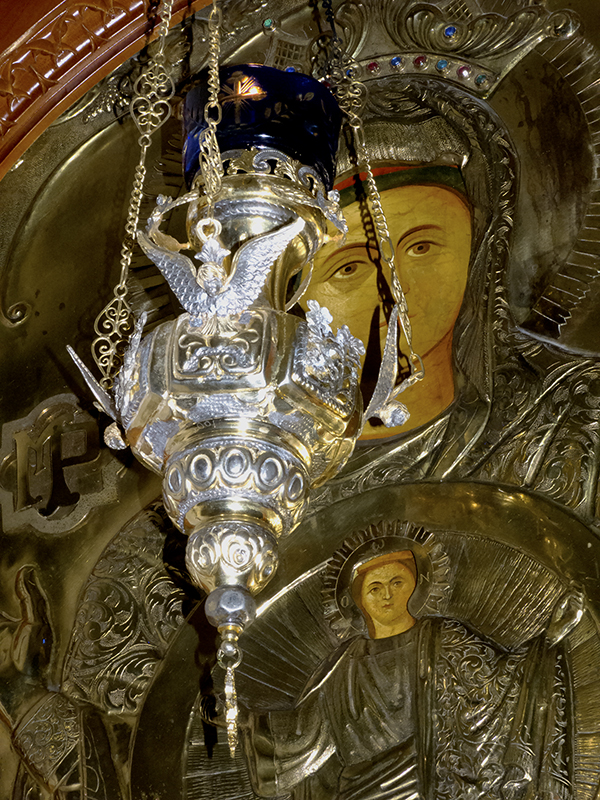

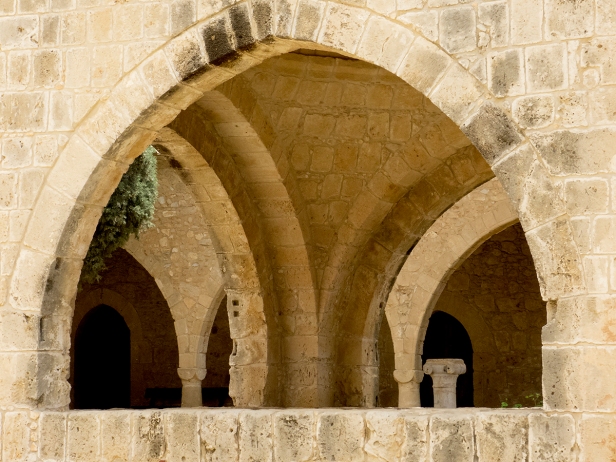
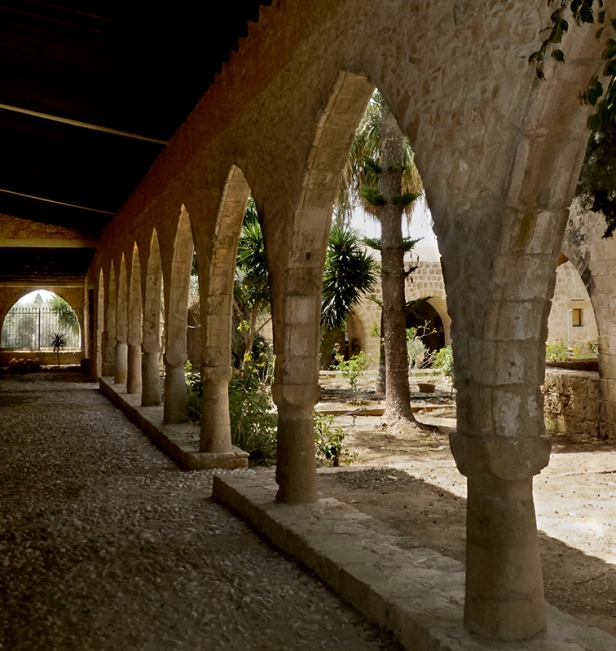
Further along the coast there are spectacular views at Cape Greco.
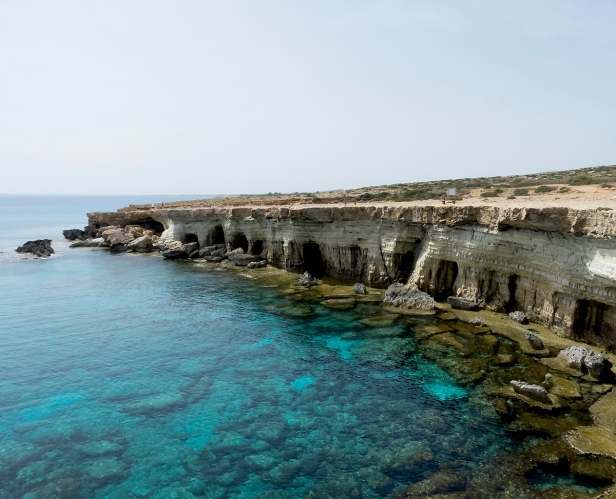
Meanwhile, back in ‘suburban’ Pyla, quietly living our mostly sedentary and restful life, our neighbor comes knocking one day with a warning.
From Don’s journal – Our neighbour across the street came to warn us that the shops will be closed for the next three days because of Easter, and to expect lots of fireworks to be set off tomorrow night. She suggested that I wear boots to go shopping in the supermarket because the place would be “heaving” with people all wheeling their shopping carts over my feet. She painted a scene of utter chaos with people shopping as if the stores were going to be closed for a month instead of three days. So we got ourselves ready to go as soon as we could and I headed to the fruit and vegetable store expecting huge lineups, people running around the store in a state of panic, and shelves stripped. Not so much. The store was busier than it had been when I went yesterday, but there was plenty of produce and people were just walking around like normal. We didn’t even have to line up for long at a cash register. Then we went across the street to the supermarket where the situation was much the same.
Our backyard has a blue pool, which is enticing and pretty, but too cold to use. It also has a large lemon tree with the best lemons I have ever experienced – no pips, tons of flavour, and copious amounts of juice. I am forever extolling their virtues – an example of the excitement of our life at this time.
Pano (upper) and Kato (lower) Lefkara are two enchanting independent but inter-related villages located on the southern slopes of the Troödos Mountains.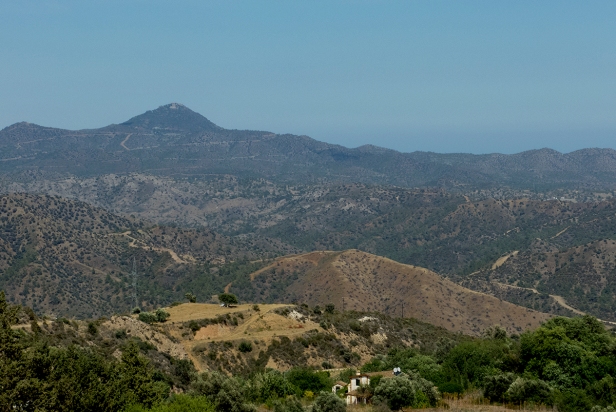
What a sweet discovery. We spend the day exploring the two stone-and-cobblestoned towns. Although the villages existed long before, most of the houses date from the three hundred years between the 1570’s and the 1870’s when Cyprus was occupied by the Turks. The towns are known for the production of exquisite lace work, and skilled silversmiths who produce fine filigree. It is still a quite common centuries-old sight to see women in groups sitting in the narrow streets making beautiful intricate lace.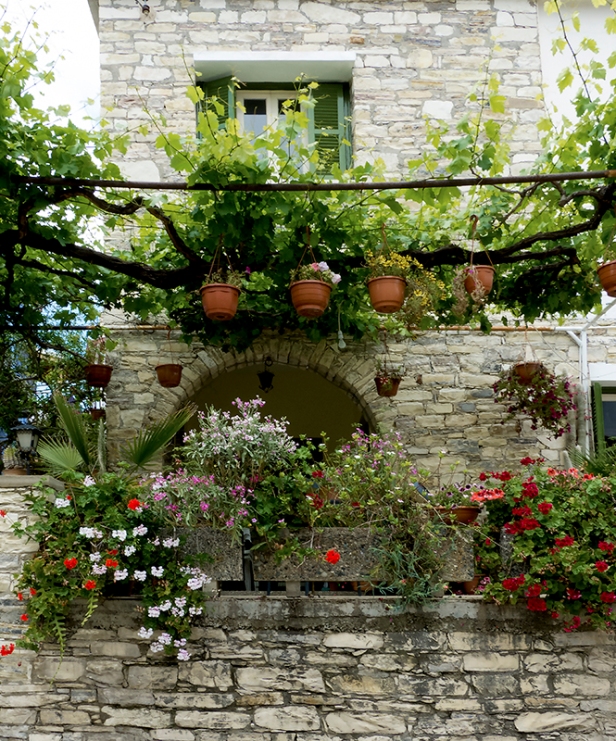
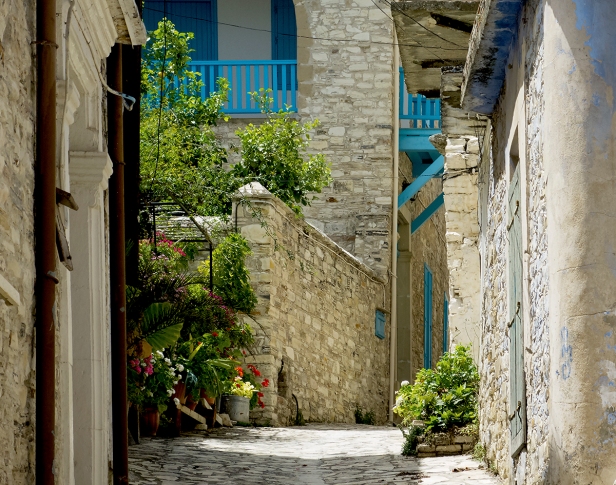
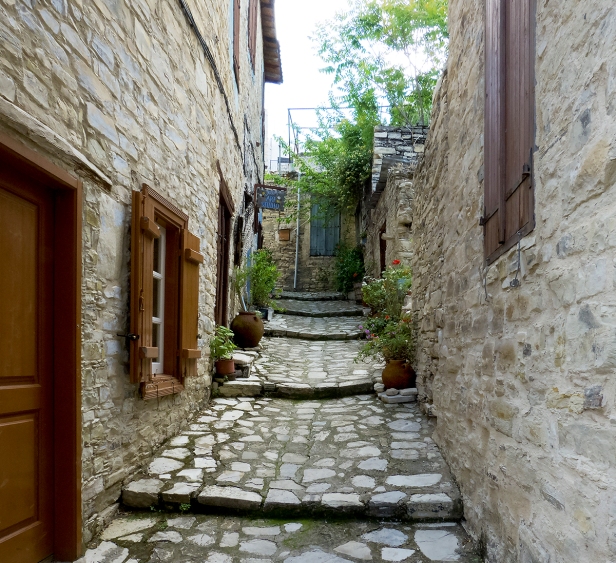

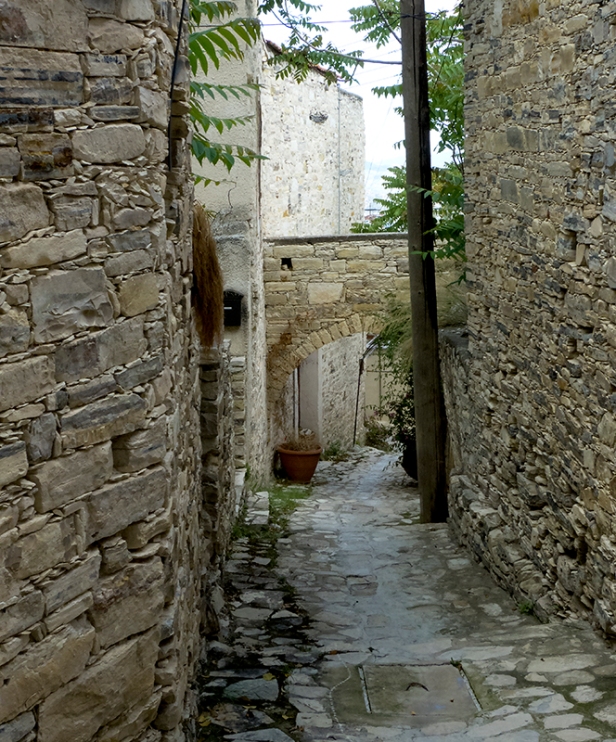

We meet this resident of Pano Lefkara who chats with us in perfect English and tells us she remembers the time before there was running water in their homes.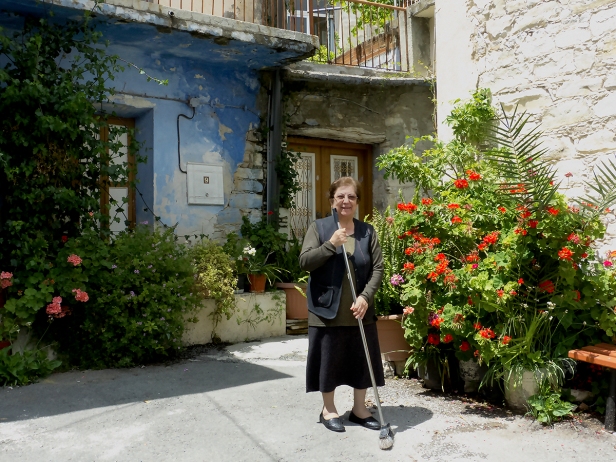
The church of Pano Lefkara, and a portion of its iconostasis.

Cyprus was a quiet time. That we even bestirred ourselves enough to get to the Lefkaras for a day was a big deal. But later things improved, and it became more interesting. Or perhaps I should say we improved and became more interested. Towards the end of our two months there we actually went on a road trip – through the Troödos Mountains and to some of the ancient ruins at Paphos and Kourion. And of course we came across some traditional dancing – all to be revealed in the next couple of posts.
All words and images by Alison Louise Armstrong unless otherwise noted
© Alison Louise Armstrong and Adventures in Wonderland – a pilgrimage of the heart, 2010-2015.

I’m confused Alison! When were you in Cyprus? You are in Vancouver now are you not; and Don is still recovering from his back problem? Paragraph 3 suggests you are there now, yet the closing paragraph tells me Cyprus was in the past. Am I being stupid?
Hariod ❤
LikeLike
Not being stupid. And not surprising you’re confused. I suspect many people will be. Including myself 🙂
I forgot to begin the post, as I usually do, with the dates we were there. I have fixed that. I hope it helps.
I’ve developed this habit of writing in the present tense when describing our experiences. Perhaps I need to re-visit that idea 🙂
Alison ❤
LikeLike
‘I’ve developed this habit of writing in the present tense when describing our (past) experiences.’
I am confused and think I am being stupid; though now unconfused and thinking I am less stupid than I am then.
H ❤
LikeLike
Chuckle 🙂
LikeLike
I used to tan nicely – then I moved to Britain, now i do what I call the British Tan: pale white>Lobster red>Brownish> pale white!!
great post as usual!! x
LikeLike
Thanks Sandra.
Don’t you love the lobster red stage?!
I guess, having grown up in Australia where the sun shines often, and summers are long and hot, and we had plenty of time to build a tan slowly, I’ve always been faintly amused (in an unbecoming smug kind of way) (:)) at Brits on their annual 2 week holiday wanting to get a tan but getting 2nd degree burns instead. Oh I am mean! And rude! If there can be rude Euros can there be rude Aussies? (FSU in-joke)
Alison
LikeLike
Don’t worry, I still laugh at them too. So at me I guess!!
I’m sure it’s fine being a rude Aussie. If you were a rude Canadian, then we’d have a problem!! 😉
See you in 5 weeks! Xx
LikeLike
I’ve always wanted to visit Cyprus and this post really brought it to life (especially the bit about red roasted Brits as I am one of them – ha!) I’m currently in Turkey – landed a few hours ago. I hope you get to visit.
LikeLike
We really want to visit Turkey, but it will be next summer. I know the way I’ve written this post is very confusing. We’re no longer actually in Cyprus – we were there in April and May. Cyprus is definitely worth seeing. Just be careful in that sun 🙂
Alison
LikeLike
Actually I was surprised to see the red-roasted Brits wearing swimsuits on the beach. I’m more accustomed to seeing Brits on the beach in dresses or suit jackets and trousers 🙂
LikeLike
Red roasted Brits only wear their dresses or suit jackets and trousers when they’re at the beach in brrrrr England. As soon as they get to the sun they go wild and lose all inhibitions 🙂
Alison
LikeLiked by 1 person
Those are really great photos. All those umbrellas made me laugh especially with your comment red roasted brits. They need some Vit D oil, lol. 🙂
LikeLike
Thanks Paulette. Many beaches in Europe (in my limited experience) are covered in loungers and umbrellas like that – you pay to rent them by the hour. Every beach we went to in Cyprus had them. They certainly need some kind of oil 🙂 – or shade.
Alison
LikeLike
You definitely covered so many places even though it was actually your time for respite. Such real adventurers you two are! 🙂 Speaking of the mosque, it seems like Muslims in different places have the habit to claim an ancient mosque in their neighborhood as the third holiest sites for Muslims in the world. I guess they’re just being proud of their heritage, which is a good thing to ensure the preservation of those old mosques. Alison, your photos really make my wanderlust kicking! 🙂
LikeLike
We really could have been way more adventurous in Cyprus had we had more energy, but yes it was our time for respite and we really needed it.
The mosque is the 3rd most important for the Sunni Muslims. I confess I don’t know anything about this branch of Islam, but it’s certainly a beautiful mosque. One day we will come to Indonesia and visit some mosques there 🙂
Glad you’re inspired by the photos. Time for another journey Bama?
Alison
LikeLike
When you do come to Indonesia, just drop me a message. I will give you some recommendation based on how much time you have in the country.
Unfortunately right now I’m very occupied with my work, and the next trip will be in March, a short trip though. So I still have a few months to come.
LikeLike
Thanks Bama, we’d appreciate your input. It always helps to know someone local.
Alison
LikeLike
Love the red roasted Brits! The water is so blue and clear. Lovely photos.
LikeLike
Thanks Kay. The Mediterranean is exquisitely blue, and when we were in Cyprus it was sunny just about every day so the sea seemed even bluer.
LikeLike
Hi Alison and Don,
Lee and I visited Cyprus briefly in 1996. One day we got to talking with an old Greek man. The conversation turned to the tumultuous history, the many nations that have occupied the island over the centuries. The man shook his head, and summed it all up in just three words: “erchounde kai fefjounde”, he said — they come and they go. Lee and I have never forgotten the man and his words ….. it was maybe the most succinct summation about human lives and human history we have ever heard from anyone: coming and going …… coming and going …….
Enjoyed your blog, and I sure wish we had known about the flamingos!
Tanya
LikeLike
Hi Tanya! We nearly came down to visit again. Wish we could have but that was when Don’s back went out.
I like that summation of Cypriot history, and human history. They come and they go. True for this whole entire thing called life.
Aren’t those flamingoes a wonderful surprise?!
Alison
LikeLike
We would have loved to see you again here on Whidbey. Some other time.
Is Don’s back better? Will you be traveling again soon? I guess we’ll learn about it in one of your next blogs.
We are being pulled, once again, to Asia ….. Nepal and Laos in particular. Probably leaving mid-November, back mid-February. If you weren’t traveling yourselves, you could be our house-sitters! 🙂 But I know you have bigger fish to fry, Don’s health permitting. Good luck with everything.
Tanya
LikeLike
Don’s back is healing well and we are greatly relieved that he won’t need surgery. We leave again at the end of Nov for 5 months in Hawaii, Samoa, Oz, NZ, Taiwan.
Have a great trip! Nepal and Laos sounds like a great combination.
Good luck to you too!
Alison ❤
LikeLike
I love the pictures and descriptions of the small villages. What a lovely, relaxing time for the both of you. I look forward to more posts on Cyprus, I place I would love to visit one day.
LikeLike
As a ‘Brit’, I enjoyed your delightful photos and the narrative.
But the lobsters are as likely to be Ukranian ones as British ones these days.
There is more to Cyprus history than the guide books say. The story varies with the teller, but there some recent books that help one understand how the island came to be divided along the dead zone.
Unfortunately some of those responsible for international efforts to reunify the Republics, don’t seem to have read any of them.
Sounds like you had a good time and go to see something of the place, despite your exhaustion.
LikeLike
Thanks Johnny. Oh I know they could be Ukrainian. Or Russian! Many Russians on Cyprus these days.
I admit I know little of the long and tumultuous history of the island. It’s in such a strategic position no wonder everyone has wanted it.
TPTB not reading the books/information that would really help solve the dispute – isn’t it always the way!
We did have a good time, and ended up seeing quite a bit. Loved Troödos especially (in the next post).
Alison
LikeLike
Thanks Darlene. It was very relaxing and much needed. We also loved those villages – so delightful to just wander around in such a natural organic place. Cyprus is definitely worth visiting.
Alison
LikeLike
Nice post Alison, and thanks for the reminder. As you may remember, we spent a week in Larnaca after a month in Athens, and it was a relaxing break. I was glad to see the interior shots of St. Lazurus, because we were there for Epiphany, and with the parade and ceremonies, there was not getting inside. ~James
LikeLike
Thanks James. We enjoyed Larnaca, and St Lazarus, and the attached (or nearby) museum. Did you see it? So many beautiful icons. The interior of St Lazarus is very typical – all those high chairs, and the usual huge elaborate golden iconostasis.
Alison
LikeLike
We are hoping to go to Cyprus in November after visiting grandkids in Israel. Thought it would make a good side trip for some walks and interesting villages. And probably not many tourists!
LikeLike
Go into the Troödos Mountains – you’ll find plenty of interesting villages and good places to walk plus 10 World Heritage exquisite tiny churches which I’ll write about in the next post (though hope it’s not too cold in the mountains in Nov). Plus I think there are many other villages like Lefkara that are not inundated with tourists. The tourists are on the beaches. Get away from the beaches and you should be okay.
Hope you have a good time on your trip.
Alison
LikeLike
I lived in Alaska for a few years and Alaskans definitely had Brits desire to escape in the winter and get a tan. They would hit the tanning parlors first, however. And then head for Hawaii. Did that myself, a few times. Minus the tanning parlor. I am not much of a beach person, however. And I believe fervently in sunblock. 🙂
Narrow walkways in Europe winding between buildings and going who knows where— I could never resist them. Their mere existence whispers adventure. –Curt
LikeLike
Yes, we Yukoners the same. Seven months with snow on the ground the urge to leavs is not surprising really. I often went back to Oz over the winters, though I also remember glorious winters of putting on my skies at the entrance to my cabin and just going for miles. It’s when the snow was still on the ground in April that it was starting to be a bit much.
I also am not a tanning person, but love being on the beach as long as I can be in the shade.
Don’t you just love the narrow winding streets of old European towns?! I can’t resist them either. In the Lefkaras we just walked – let’s go down here, oooo look at this, let’s see where that goes . . . . . around every corner, under the tunnels, up and down. So much fun.
Alison
LikeLike
Had access to a cabin up on the crest of the Sierra Nevada Mountains for several years where we would cross-country ski out our door, and wander for miles. It was a joy.
I can handle a beach if I am in the shade, I have a good book, and it is a rugged coast with lots of sea life. 🙂
And I feel the same way about those narrow, wandering walkways as I do a trail in the wilderness. They beg to explored.
Curt
LikeLike
Thank you for keeping the trail fresh even as you have moved on! You retrace and bring us all along, the way! (You didn’t include any recipes for those red roasted brits. I was thinking with a little basil, olive oil and balsamic vinegar?) xo! marga
LikeLike
Thanks Marga. The retracing means a second journey for me too.
I do like the idea of basil, olive oil and balsamic. Mmmm, tasty! 🙂
Alison xo
LikeLike
Oh, those lovely stone walkways with plants – I’m entranced!
LikeLike
Aren’t they fabulous?! Most European small towns and villages have something similar – just begging you to get lost exploring. I am always entranced by them.
Alison
LikeLike
When I was thumbing around Europe (back in the day – seems like a lifetime ago – er – it was), I was carefully balancing a thirty pound + backpack over my spine. When those meandering stone passageways called to me then, I was somewhat selective about which ones I could [physically] explore. Something about your photos evoked that long-ago memory. My thanks.
LikeLike
Fantastic pictures! It’s so… well, normal… to have some quiet time. And honest. Love it.
LikeLike
Thanks Shirley. Yes, it was wonderfully normal. Doing not much, reading, watching movies, going for walks on the beach – wonderfully normal and much needed.
Alison
LikeLike
Beautiful and relaxing post! Great set of impressive photos 🙂 Bye. K.
LikeLike
Thanks so much Kamila.
Alison ❤
LikeLike
So the Brits are burning their skin all over the world? I met many young volunteers from the UK during my four and a bit months in Thailand. They were mostly there for two weeks only and often sunbaked in the midday sun or swam in the surf late at night. As an Australian, I found it disturbing but I realised that they were never going to listen to me. I’m in Luang Prabang on a break at present and will look at your blog to see if you went there.
LikeLike
Apparently so. I guess if you live in a mostly cold grey climate 2 weeks of hot weather is a once a year pilgrimage of sun worship.
I see you found the posts on Luang Prabang 🙂
Alison
LikeLike
your photos of Cape Greco are stunning… looks pretty isolated though, were many people there?
LikeLike
Thanks Phyllis. It is a really stunning place. And the Mediterranean really is that blue. And azure, and cerulean, and cobalt and gorgeous.
Cape Greco is not far from the tourist town of Ayia Napa so there were a few people there but it certainly was not crowded.
There are some vids on youtube of people jumping into the sea from the cliffs! Pretty spectacular.
Alison
LikeLike
Love the pics… the sausage one, especially. 😀
LikeLike
Thanks Kev. I thought the sausages deserved a mention 🙂
Alison
LikeLiked by 1 person
😀
LikeLike
What an incredible recap – the sausages, the red roasting Brits, Cape Greco and those beautiful narrow streets! I appreciate the info on a place I knew very little about, it looks wonderful!
I’m looking forward to reading your other posts on it!!
Hope you’re both doing really well!
~ Andrea ❤
LikeLike
Thanks Andrea, glad you enjoyed it. We knew practically nothing about Cyprus too, until we went there. We didn’t really see all that much of it, but what we did see was fabulous. Lots of history there.
We’re both doing much better thanks. Hope you guys are well too and still enjoying Korea!
Alison ❤
LikeLike
I’m really glad to hear you guys are doing so well and especially how you’re going about healing is just truly wonderful and as I’ve said, inspiring!
We’re doing well here. We’re super close to paying off our debt (June next year) so we’re really looking forward to getting that number to zero, it’s the new rich these days! 😀
Korea has it’s moments, for the most part I’m getting a bit tired of it. Lots of cultural things that wear on me, but I’m using it as good practice in processing my emotions and being honest with myself and Matt about where I’m at.
I’m needing some of that sweet Canadian wide open space and fresh air I think. We’re heading to California in Jan to see my parents, so I imagine that will give us a much needed North American reset! I’m elated just thinking about being able to shop for clothes that fit and being surrounded by a variety of cultures again!! 😀
~ Andrea ❤
LikeLike
Sounds like your time in Korea is an excellent challenge for developing graceful authenticity.
Hope you have a *great* North American vacation, and that you get filled up again with that “home” feeling even if it’s not Canada. California is pretty nice I believe 🙂
Alison
LikeLike